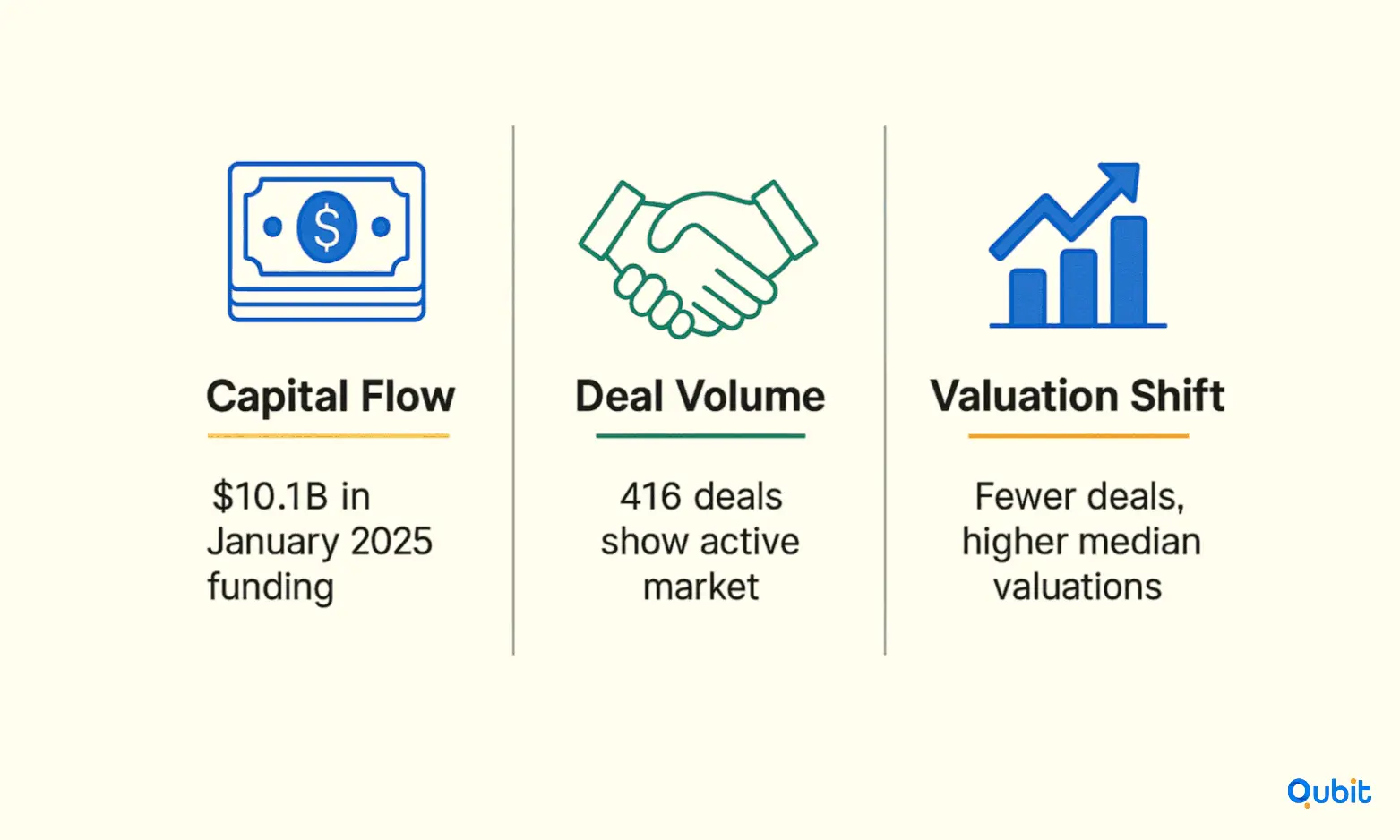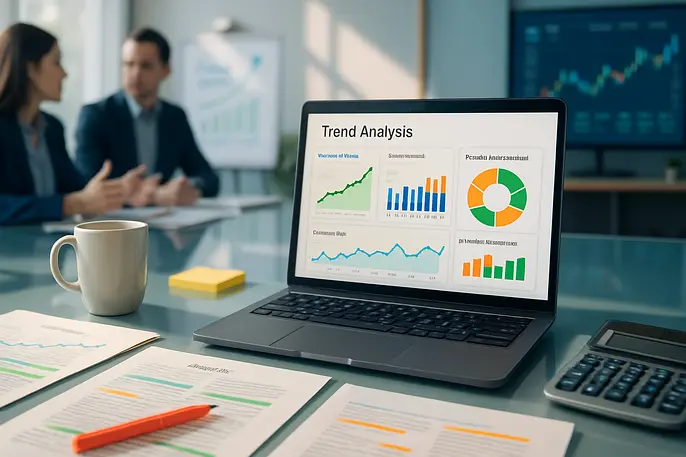Spotting market opportunities is the cornerstone of successful startup investments. Trend analysis, a method of identifying patterns and shifts in industries, offers investors a powerful tool to uncover emerging prospects. By examining data-driven insights, investors can anticipate changes in consumer behavior, technological advancements, and economic shifts that shape the startup ecosystem.
Your assessment of market trends gains added depth when considering how to do startup outreach for investors, which connects broader outreach strategies with trend analysis in startup investments.
Whether it's workforce analytics or digital transformation, trend analysis helps pinpoint areas with high growth potential. Let’s explore how this approach can refine investment strategies and unlock untapped opportunities.
What “trend analysis” means for venture investors
In venture, trend analysis connects three layers: macro context (rates, liquidity, regulation), sector dynamics (competition, profit pools, value chain shifts), and micro leading indicators (hiring velocity, product launches, developer traction) to form testable hypotheses about where value accrues next. The objective isn’t prediction for its own sake—it’s to place earlier, at better prices, in founders operating at the inflection of durable demand and capital efficiency.

- Macro steers cycle awareness: monitoring interest rates, inflation, and growth influences risk appetite, valuation regimes, and exit windows, shaping stage focus and check pacing.
- Sector analysis parses profitability and competitive pressure so theses follow shifting profit pools rather than narratives, using structured frameworks to avoid bias.
- Micro signals validate timing by surfacing adoption and talent movement before revenue shows up in lagging metrics, enabling contrarian yet evidence-based entry
Your exploration of market opportunities is extended by insights on how to find promising startups to invest in, linking practical sourcing methods with analytical approaches.
Workforce data is more than just numbers; it’s a narrative of a company’s strategy, priorities, and potential. When combined with AI-powered tools, these insights become a powerful asset for making informed investment decisions.
Market Valuation and Trends Analysis
Startup valuation is a constantly shifting target, shaped by the interplay of global and local market trends. As industries evolve, factors such as regulatory changes, environmental standards, and investor sentiment redefine how startups are assessed. This dynamic nature demands a proactive approach to valuation modeling, ensuring businesses stay ahead in competitive markets.
Predictive analytics plays a pivotal role in decoding valuation dynamics. By analyzing historical data and forecasting potential outcomes, startups can anticipate market fluctuations and adjust their strategies accordingly. Tools like scenario analysis allow businesses to model various outcomes based on regulatory shifts, market trends, and investor sentiment. For instance, applying scenario analysis can help forecast best-, worst-, and expected-case valuation scenarios, offering clarity in uncertain environments.
Investor sentiment, often driven by broader economic conditions, adds another layer of complexity. Valuations can fluctuate significantly across investment rounds, reflecting shifts in confidence and market dynamics. To illustrate how startup demo days mirror real-time shifts in the investment landscape, explore investor-demo-day-tips for actionable insights into maximizing deal flow during these pivotal events.
Startup Growth & Funding Trends
The startup ecosystem continues to evolve, revealing critical insights into growth and funding patterns that shape market opportunities. January 2025 alone saw $10.1 billion in startup funding, underscoring robust investor interest despite fluctuating economic conditions. This figure highlights the magnitude of capital flowing into innovative ventures, offering a glimpse into sectors ripe for investment.

Investment activity also remained strong, with 416 deals recorded during the same period. This metric reflects consistent deal-making trends, providing investors with a benchmark to assess market dynamics. While the number of deals indicates activity levels, the 2025 Funding Outlook reveals a nuanced picture: research data points to declining deal volumes but rising median valuations. This trend suggests that while fewer startups are securing funding, those that do are commanding higher valuations—a signal of quality over quantity in the current market.
For investors seeking actionable insights, correlating funding data with performance metrics is essential. Understanding how startups adapt to shifting market conditions can help pinpoint ventures with high growth potential. Additionally, your evaluation of market trends gains an additional dimension when considering find-startups-through-accelerators, which details alternate avenues for identifying emerging startups through specialized programs.
A Practical Framework to Spot and Size Opportunities
Start top-down with macro and capital flow context
- Track the cost of capital, liquidity, and investor sentiment to calibrate entry timing and required proof points; post-2021 corrections re-centered diligence on fundamentals and smaller, staged deals across regions and sectors.
- Use quarterly rollups (trendbooks and LP/GP surveys) to see where dry powder and conviction concentrate (e.g., AI, climate, deep tech, fintech), then test whether those flows reflect sustainable demand or momentum.
Apply sector frameworks to locate shifting profit pools
- Combine Five Forces and the 3Cs to map power dynamics, buyer leverage, switching costs, and where data or distribution can compound advantage; this replaces anecdote with a standardized view of moat feasibility and margin durability.
- Run PESTEL scans for regulation, sustainability mandates, and geo-fragmentation that create enforced demand (e.g., compliance tech, grid modernization), which can be more durable than trend buzz.
Validate with leading indicators rather than lagging metrics
- Observe technology adoption curves where tooling lowers cost or unlocks new jobs-to-be-done (e.g., AI copilots across vertical SaaS, autonomy in logistics), supported by platform and ecosystem signal.
- Monitor developer and product surface signals: repo velocity, integration launches, and category-specific hiring surges that precede revenue by quarters, especially at seed/Series A.
Cross-check with funding mix and stage patterns
- Rising seed activity with restrained late-stage capital often indicates true exploration plus valuation discipline; align check size and evidence bar accordingly, avoiding thesis drift during liquidity droughts.
- Category-specific capital cycles matter: climate and digital health show sustained institutional interest with a shift toward commercially viable pathways and adaptation tech, suggesting more pragmatic underwritings.
Where the opportunities are concentrating in 2025
- AI as an infrastructure and workflow layer: commoditizing certain capabilities while creating openings in vertical SaaS, agentic ops, and data-rich workflows where distribution and domain depth matter more than model novelty.
- Climate and energy transition: investor dry powder and policy tailwinds are pushing capital toward commercially viable decarbonization, grid software, adaptation (e.g., wildfire detection, storage), and AI-enhanced monitoring, areas where payers already exist.
- Fintech and embedded finance: DeFi experimentation and tokenization re-emerge alongside pragmatic fintech infra; opportunities skew to rails, compliance, and B2B embedded flows versus consumer speculation.
- Deep tech and robotics: investor surveys show momentum in deep tech and automation as supply-chain resilience and labor constraints persist; diligence emphasizes proof of readiness, unit economics, and certification paths.
These areas are not merely “hot”, they exhibit reinforcing signals across macro, sector structure, and micro adoption that improve the odds of durable value creation if underwriting focuses on efficiency and buyer ROI.
How to operationalize a trend analysis engine
- Establish a monthly macro-to-micro review: Update a one-pager per thesis with rates, sentiment, and exit windows; revisit sector maps with Five Forces/3Cs/PESTEL snapshots; attach a living sheet of leading indicators and highest-signal companies.
- Tie sourcing to signals, not volume: Prioritize founders showing pre-consensus traction (design partners, security readiness, integration depth) in categories with supportive macro/sector backdrops; this raises hit rates without inflating funnel size.
- Measure input quality and conversion: Track qualified conversations, second meetings, and diligence starts stemming from signal-driven sourcing versus generic lists; expect tighter conversion when top-down and bottom-up align.
- Adjust bar by cycle: In cautious environments, require clearer path-to-paid and capital efficiency; when liquidity improves, expand exploration but preserve signal gates to avoid regression to narrative-driven bets.
Example: Applying the Method to Two Hot Categories
- Vertical AI SaaS: Macro conditions keep capital selective; sector analysis shows incumbents with distribution but gaps in domain workflows; micro signals include rapid integration launches and practitioner-led adoption; underwriting favors teams with proprietary data access, regulated-buyer fluency, and sub-12-month payback.
- Grid software and storage: Policy and reliability concerns push budgets toward grid digitization; sector maps reveal fragmented incumbents and rising interop needs; micro signals include utility pilots and adaptation spend; diligence centers on standards, integration timelines, and procurement sequencing
Metrics that keep trend-driven investing honest
- Fund-level: IRR, MOIC, TVPI/DPI and loss ratios benchmark whether trend bets translate to realized outcomes, not just paper marks.
- Deal-level: payback, net revenue retention, and gross margin trends confirm whether the trend is producing healthy unit economics, especially in infra and SaaS.
- Sourcing-level: qualified replies, second meetings, and diligence initiations from signal-led theses vs. generic outreach ensure the engine compounds learning and results.
Conclusion
Integrating workforce analytics, digital transformation tools, and market valuation insights into your investment strategy is no longer optional, it’s essential. These elements empower investors to make data-driven decisions, identify emerging opportunities, and mitigate risks effectively. By adopting a narrative-driven approach to trend analysis, you can uncover the deeper stories behind startup growth, ensuring your investments align with both market demands and long-term potential.
If you're ready to align your investment strategy with emerging market trends, we at Qubit Capital invite you to explore our Startup Matchmaking service for tailored investment opportunities. Let us help you connect with startups that match your vision and goals.
Key takeaways
- Integrating trend analysis with workforce, digital, and market valuation insights leads to smarter investment decisions.
- AI-driven workforce analytics offer early predictive signals for startup success.
- Digital transformation tools provide real-time data crucial for spotting market opportunities.
- Understanding dynamic startup valuation is key to navigating investment risks.
- A systematic trend analysis process is essential for informed and effective investment strategies.
Frequently asked Questions
What are the latest startup trends?
Recent data indicates dynamic shifts in startup growth, with emerging industries and innovative business models driving the landscape.






